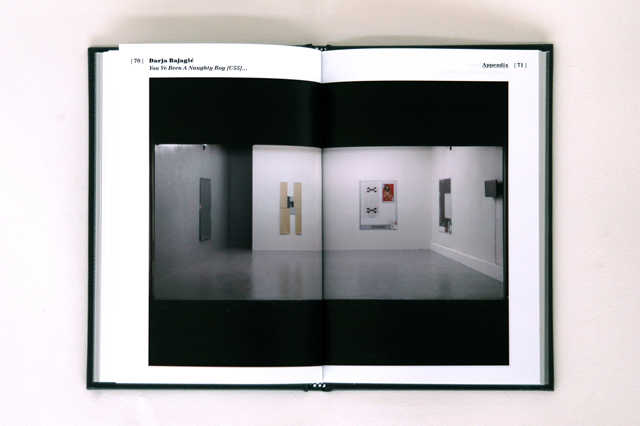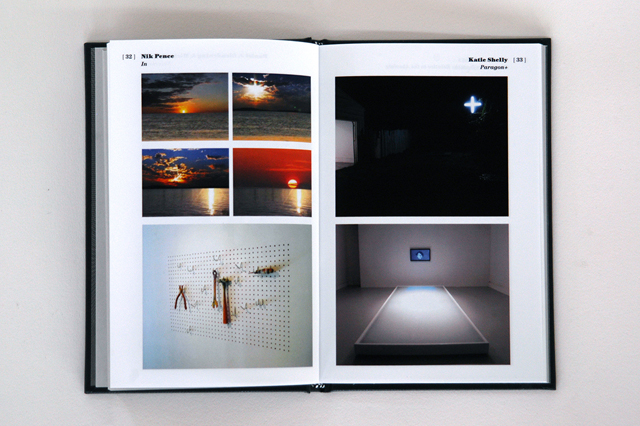The end is as good a place to start as the beginning, especially when it comes to American Medium. It’s an until recently nomadic online and offline project that’s been running for two years, now settling in BedStuy, Brooklyn, and extending its operations to a permanent exhibition space, “office, garden sanctuary and outdoor artist’s studio”. There’s a kickstarter campaign, ending February 28, to help fund it and it’s run by two of the past six curators of art space anomaly Appendix. As key members of the renowned and now defunct suburban gallery in Portland, Travis Fitzgerald and Josh Pavlacky (along with Extra Extra’s Daniel Wallace) have plenty of experience in creating a supportive environment for interesting artists to work within.
A collective and an art space that established itself at the forefront of the drive to grasp “the divide between the physical and the digital”, as American Medium continues to do, the Appendix retrospective and elegy to a dynamic bygone era, was conceived by some of its core members and published by Container Corps on the gallery’s close in 2013. Starting at its end, the book becomes a document deconstructing documentation and a presentation of art that interrogates ideas of framing and interpretation through its own resulting abstraction.

As Fitzgerald flatly puts it in the Kevin Champoux-led interview ‘It’s a Garage, Not a Gallery: Appendix at 5 Years’ –including past curators Fitzgerald, Pavlacky, Zachary Davis, Maggie Casey, Ben Young and Alex Mackin Dolan –the space was nothing more than “a garage in a house”. Maybe so, but as said Google Hangouts conversation reveals, what began as a naïve foray into a project begun by a bunch of recent graduates who “really didn’t know anything”, Appendix became one of the most vital hubs of what you might call the ‘post-internet’ conversation (“Net art merging with formalism? It’s hard to say”).
It’s in this ordinary house “that smells vaguely of three men cohabiting in little rooms” with its two car garage-come-gallery glowing “like a television set” –according to David Knowles in ‘Full Spectrum’ –that artists like Bunny Rogers and Darja Bajagić became some of the last exhibitors in 2013. It would take a highly supportive and independent space, driven on intuition, that would make something like Bajagić’s You Ve Been A Naughty Boy [C55]
1.e4 e5 2.♘f3 ♘c6 3.♗c4 ♘f6 4.d4 e×d4 5.0-0 ♗c5 6.e5 d5 7.e×f6 d×c4 8.♖e1+ ♔f8 9.♗g5 g×f6 10.♗h6+ ♔g8 11.♘×d4 ♗×d4 12.c3 ♗f5 13.c×d4 ♘×d4 14.♘c3 ♗g6 15.♖e8+! ♕×e8 16.♕×d4 ♕e5 17.♘d5!!, 1-0, exhibition title fit the pages of the Appendix ‘Exhibition History’. Also listed are Tabor Robak, Justin Bland and Brenna Murphy in the early days; Sean Joseph Patrick Carney’s Boyz Night Out, Dump.fm and The Jogging at its satellite sister-galleries Hay Batch and Little Field. Iain Ball and Katja Novitskova making appearances online.
Jasper Spicero, Bea Fremderman, MSHR, Brian Khek and Micah Schippa also make up just a fraction of the exciting artists to show through those garage doors between 2008 and 2013, for a short residency meant as a place to sleep and support a practice in the isolation of suburban Portland. Andrew Norman Wilson swung an Apple mouse by its cord around his head while dancing to Jackson Browne’s ‘Doctor My Eyes’, according to Gene McHugh’s collaborative short story ‘Andrew Norman Wilson at Appendix Project Space’. Daniel J. Glendening took time for an atomic description of a rotating rock at the exhibition on which ‘Daniel Baird, This New Ocean’ is based –all the while submitting to that realm that Knowles describes as where “rumor and memory begin their work”. Knowles compares galleries to tombs where “acts of life and labor end”, while Amy Bernstein’s incredibly evocative stream of thoughts on “the collective voice of expressive peoples giving form to contemporary experience” in ‘When the Walls Are White’, is underpinned by a question recurring throughout Appendix: “what if the new norm was that the documentation WAS the thing?”
In the context of the Appendix book –conceived by the art space curators, curating documents of exhibitions they already curated –it’s both interesting and overwhelming to consider the infinite interpretations and abstractions of an artist’s work and the ‘creative degradation’ that happens within that. After all, Appendix the book is first hand experience, bound, framed and formatted through text and photography. Those exhibitions, in turn were the product of intense critique and conversation between artist and curator, constructing a unique exhibition tailored to the dimensions of a unique space. Even this very overview on this particular website is framing the book, the gallery, and the work in a way that is specific to its relevance to the continued and evolving ‘net art’ conversation at American Medium. It’s for this reason that perhaps the most thought provoking piece comes from Lisa Radon’s closing ‘APPENDIX’ (or Appendix appendix, Appendix appendix appendix, even). It’s a fascinating deconstruction of communication as embedded in and limited to its lexicon, building on Bernstein’s initial question: “when we look back at this time in art history what will we remember?”

Equal parts enlightening and indecipherable, across computer coding, Finnegan’s Wake footnotes and seemingly endless postscripts, ‘APPENDIX’ interrogates Appendix as both art space and idea, through Minecraft, CSS and the history of the American residential garage. “Do you remember a time before things were so codified, ossified?” Radon asks, in relation to the visual signifier of “the ransom note typography of the Sex Pistols” that a Finnish punk band, also called Appendix, borrows as its logotype. Rózsa Farkas questions historicity in ‘Five Years’, outlining the progress of DIY gallery movements of the past to illustrate their effects on the present and leading to the conclusion that artist-run spaces “now have to deal with the marketability of art that older movements brought about”.
Hence, the vitality of Appendix and now American Medium, self-funded and caught in Knowles’ “looping progress of time”, where artists and curators return to carry on and build upon “the full spectrum suspended present available to us immediately and always”, within these realms of net art now contained within the walls of a space in Brooklyn. It’s here that one wonders whether this new more permanent space, with its defined public function, will no longer be the dynamic hinterland only a re-purposed residential garage “stuck somewhere between lost histories and unimaginable futures” could be, but the “relic, a piece of evidence” Glendining outlined in his fetishistic examination of a rock. There’s really only one way to find out. **













